How to Treat Your Wood Cutting Board For The Long Term
Learn how to treat your wood cutting board so it will retain its life for years to come. Find out how to store, wash, dry, and store a wooden cutting board.
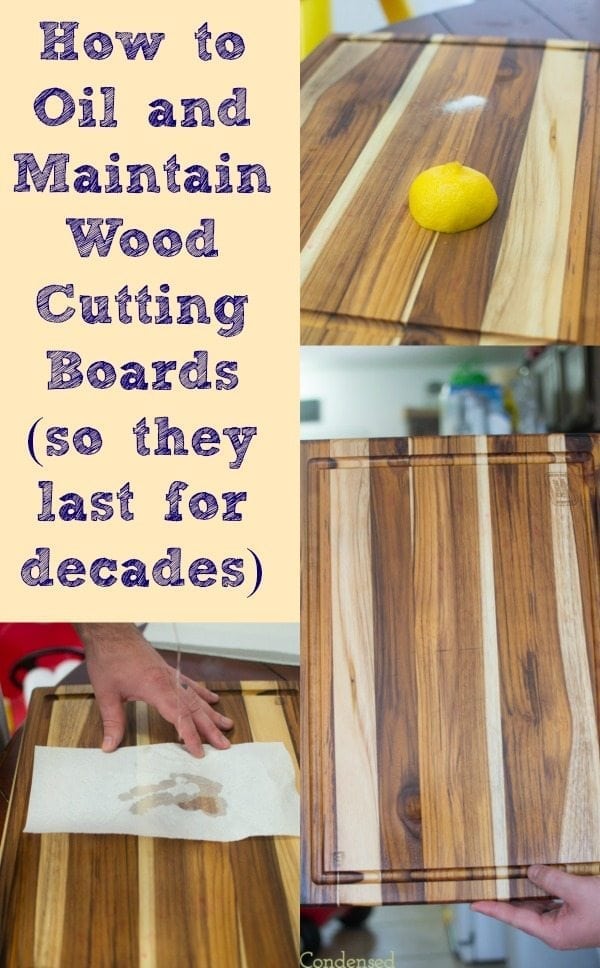
I remember in high school, one of my friends told me that her mom said that everyone needs a high-quality wood cutting board. I remember thinking, “Weird. Not the first thing that comes to mind when I think of ‘must-have kitchen item.'” However, I totally get it now.
Not only are they sturdy and can last for many decades, but they just look nice. We’ve acquired a few over the years, and I feel like they are some of our most prized kitchen items. They even make their way into about half of our pictures on this blog.
While plastic cutting boards are cheaper and generally work fine, they aren’t meant to last forever. If you’ve seen a plastic cutting board that has been using for a while, it’s full of cuts and perhaps even miscolored a little bit. However, with a nice wooden cutting board, it’s something that actually just looks better with time — you could even pass it down to your family. And honestly, you can have the best knives in the world, but if you don’t have a quality cutting board, you might as well not have good knives!
Wood cutting boards are made out of natural materials, which means they will wear down over time. It is important to know how to properly care for your wood cutting board in order to make it last.
The wooden cutting board is an expensive kitchen essential. But without proper care, it can become scratched, hard, and fall apart entirely. Follow these tips to make your wood cutting board last for years!
- First: Why Wood Cutting Boards
- Types of oil for cutting boards :
- How often do you need to use the oil on the cutting board
- Supplies
- Instructions:
- Removing unpleasant smells from wood cutting board
- How to Sanitize Wood Cutting Board
- Best Wood Cutting Boards
- How to Increase the Life of Wood Cutting Board
- Is it necessary to finish a wooden cutting board?
- How to Store Wood Cutting Boards
- More Cleaning Posts You Might Enjoy:
First: Why Wood Cutting Boards
There are two types of cutting boards, wood and plastic. There are pros and cons to each type. Wood is more expensive but it will last much longer than a plastic board which costs less. The edges on a plastic cutting board will wear down and become very sharp, which can be dangerous when using them. I prefer wood because it doesn’t get as hard or brittle over time like the edges of a plastic board.
Wood cutting boards are not only great for chopping vegetables, but they also help to protect your knives. Wood is a natural material that will maintain the edge of your blade and prevent it from getting dull.
Wood cutting boards are a safer option than plastic because they will not scratch your knives or dull them as easily as some other materials do.
They also are less likely to harbor bacteria and mold than other materials like plastic or bamboo; this is because the surface of a wooden board has small pores that trap liquids and prevent them from seeping into the wood. Wood also has natural antibacterial properties, and it’s easier to clean than other materials like plastic or bamboo because you can just use soap and water.
Types of oil for cutting boards :
Mineral – Oil: This type of oil is the most expensive and can’t be used for cooking because it’s not edible or healthy. The good thing is that it lasts a long time, but the downside is that you have to keep buying it over and over again.
-Olive oil: This type of oil is great for cutting boards because it penetrates deep into the wood and protects against bacteria. It’s also healthy, so you can cook with it, too.
-Vegetable oil: This type of oil is the most popular and very cheap, but it doesn’t last as long as other oils like olive or mineral. If you want to use vegetable oil, make sure to buy it in bulk.
-Coconut Oil –
It may be tempting to use a cheaper oil, such as vegetable or canola oil, but the smell of them will ingrain itself into the board, making it smell strongly of either of those oils. The cutting board oil we bought was about 9 dollars, but after using it several times, it doesn’t even look like we used it. It should last you a long time, especially since you won’t need to use it every time.
How often do you need to use the oil on the cutting board
You really only need a few minutes each month to do the in-depth maintenance to keep them looking nice. If you use them very frequently, you might want to treat them more than that, and if you don’t use them much at all, you could probably get away with more than a month. However, wood cutting boards should be cleaned off with hot, soapy water after every use. Make sure to not put them in the dishwasher, pat them as dry as you can with a dish cloth, and then let them dry the rest of the way.
Supplies
- Salt and Lemon (or baking soda)
- Butcher Block and Cutting Board Oil (we bought ours at Home Depot) or another compatible oil
- Clean dish cloth
Instructions:
1. Place about a teaspoon of salt directly onto a cutting board. You can either put about a tablespoon of lemon juice on top of the salt or use half of a lemon to spread the salt around.
2. Spread the salt around with the lemon (or if you use lemon juice + water, use a clean wash cloth), making sure to get all nooks and crannies of the board scrubbed well with it. The lemon and salt act as an anti-bacterial and helps get rid of any bacteria that may be lingering from the more frequent cleanings.
3. Wash off all the salt and lemon with warm water.
4. Using a cloth dishcloth, dry off the board as much as you can. Wait until it’s completely dry to move onto the next step.
5. Either pour a small amount of the oil directly onto the board, or onto a clean paper towel.
6. Rub the oil around on the cutting board until it’s well oiled — make sure to get all parts of the board, including the back side (even though you don’t probably use that part as much, or even ever, it’s still important to treat!)
7. Let it dry completely before storing! Enjoy your beautiful cutting board!
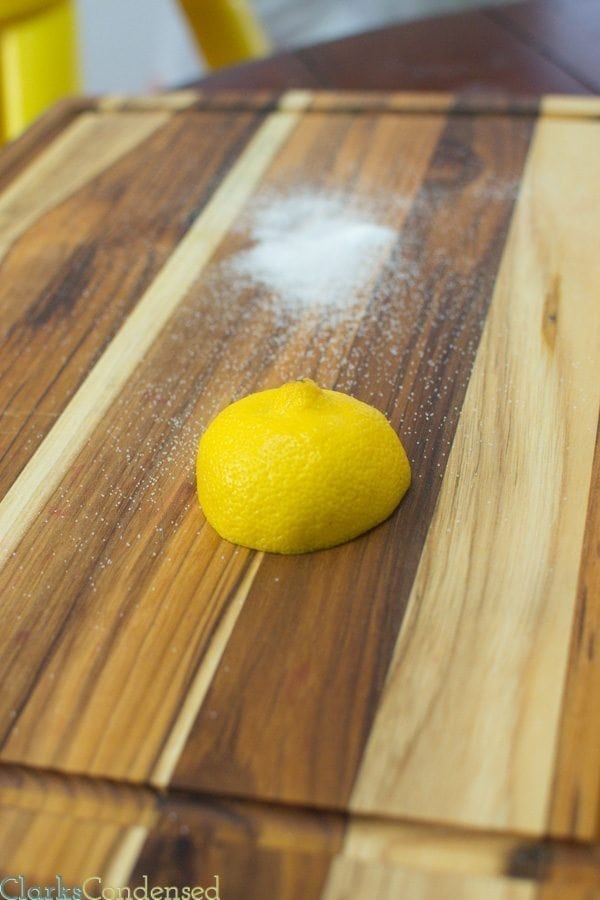
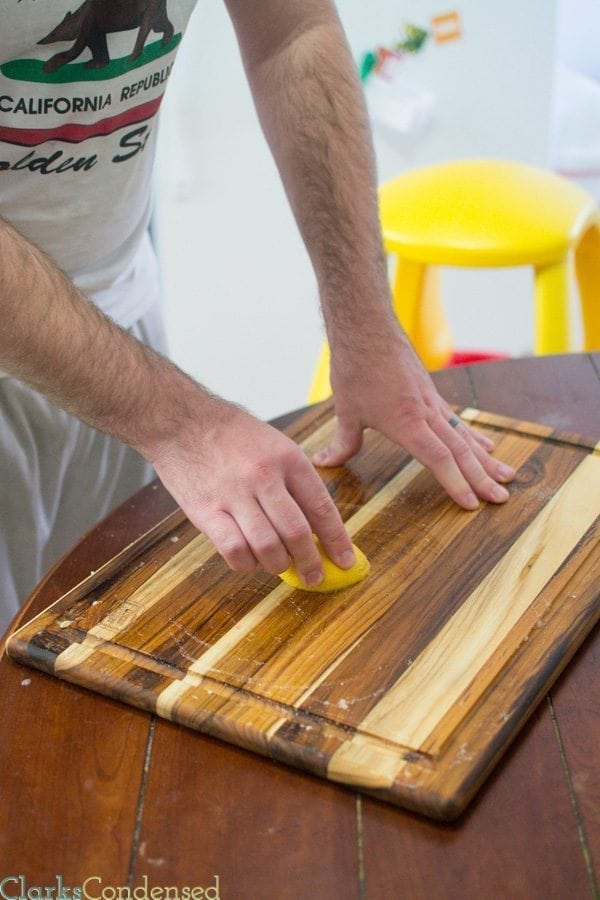
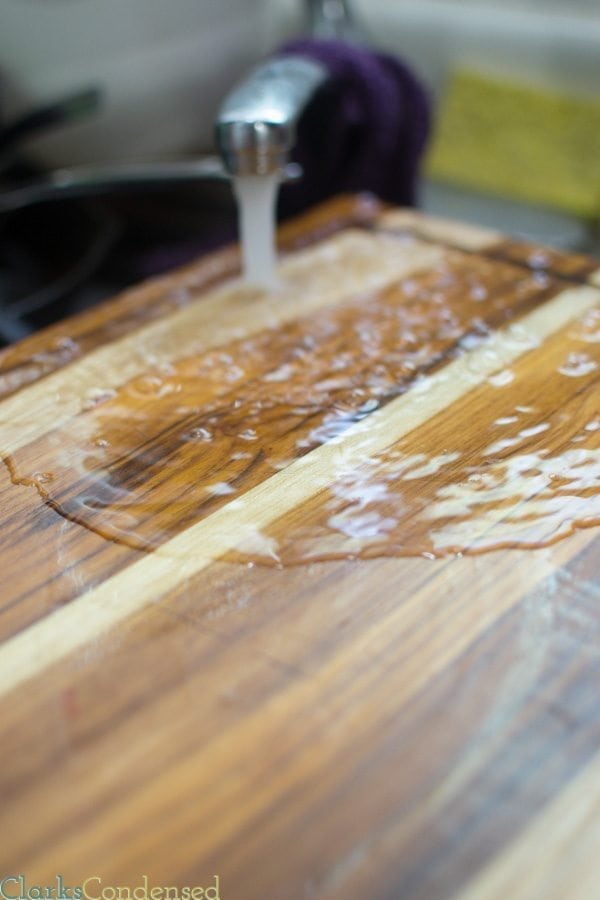
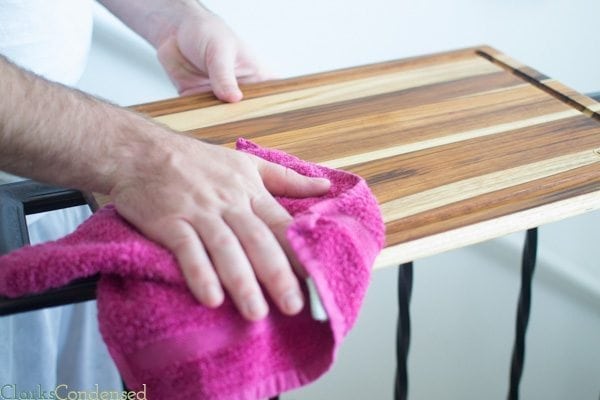
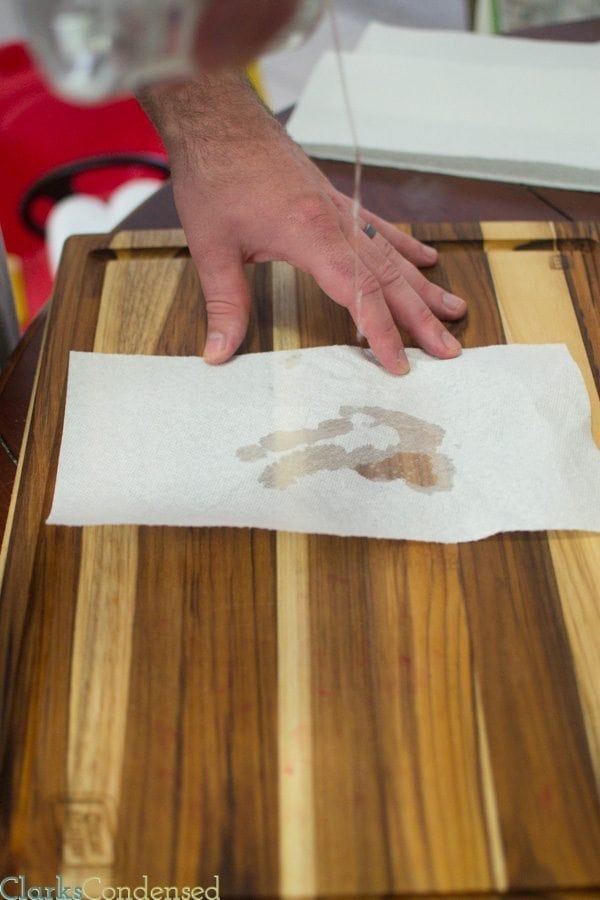
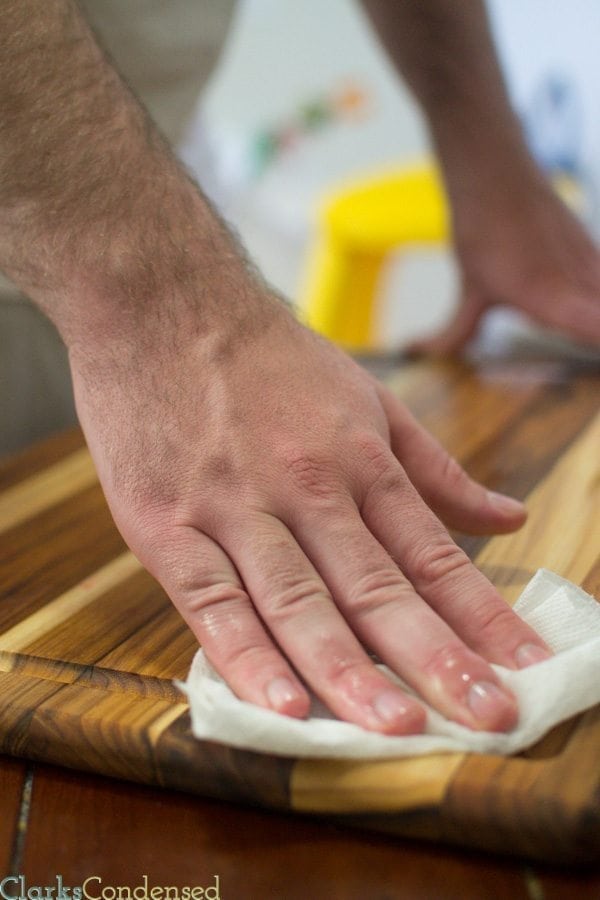
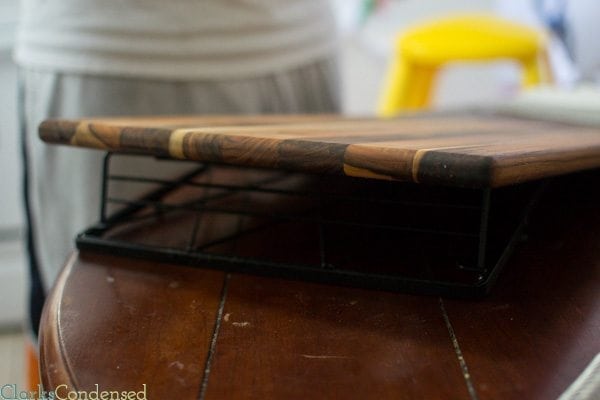
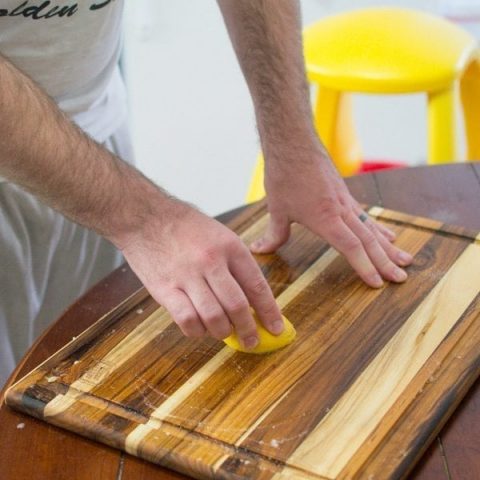
How to Treat Your Wood Cutting Board For The Long Term
Materials
- Salt and Lemon (or baking soda)
- Butcher Block and Cutting Board Oil (we bought ours at Home Depot) or another compatible oil
- Clean dish cloth
Instructions
1. Place about a teaspoon of salt directly onto a cutting board. You can either put about a tablespoon of lemon juice on top of the salt or use half of a lemon to spread the salt around.
2. Spread the salt around with the lemon (or if you use lemon juice + water, use a clean wash cloth), making sure to get all nooks and crannies of the board scrubbed well with it. The lemon and salt act as an anti-bacterial and helps get rid of any bacteria that may be lingering from the more frequent cleanings.
3. Wash off all the salt and lemon with warm water.
4. Using a cloth dishcloth, dry off the board as much as you can. Wait until it’s completely dry to move onto the next step.
5. Either pour a small amount of the oil directly onto the board, or onto a clean paper towel.
6. Rub the oil around on the cutting board until it’s well oiled — make sure to get all parts of the board, including the back side (even though you don’t probably use that part as much, or even ever, it’s still important to treat!)
7. Let it dry completely before storing! Enjoy your beautiful cutting board!
Removing unpleasant smells from wood cutting board
The smell of raw meat can linger on wood cutting boards, making it difficult to store them in open spaces. There are a couple of ways that you can remove the odor from your board. You can cover the board with a thin layer of mineral oil. You can also scrub it down with baking soda or vinegar, which will break down the molecules that are causing the odor. The best way to remove the smell is to boil water with a few drops of lemon oil in it. The boiling process will kill any bacteria that might be causing odors.
How to Sanitize Wood Cutting Board
The first step to sanitize a cutting board is to wipe it down with a dry cloth. Next, scrub the board using an all-purpose cleaner and water, then rinse thoroughly with water. Finally, use a clean towel to dry the board and place it in an area that is not exposed to sunlight or air currents.
If you are looking to preserve the life of your cutting board for a long time, it is important that you treat it on a regular basis. The best way to do this is by scrubbing it with an all-purpose cleaner and water.
The first step to sanitize a cutting board is to wipe it down with a dry cloth. Next, scrub the board using an all-purpose cleaner and water, then rinse thoroughly with water. Finally, use a clean towel to dry the board and place it in an area that is not exposed to sunlight or air currents.
The best way to prolong the life of your wood cutting board is to clean it on a regular basis. To do that, you will need an all-purpose cleaner and water.
The first step in sanitizing the board is to wipe down with
Best Wood Cutting Boards
Here are some of the top five cutting boards that you can get on Amazon
How to Increase the Life of Wood Cutting Board
If you want to keep the life of your cutting board for a long time, here are some tips on how to treat it.
- Do not use your wood cutting boards with metal utensils because this may scratch the surface of your board and can cause your board to crack and break.
- Make sure that the surface of your cutting board is dry before you put it away after it has been washed with soap water or liquid dish soap.
- Apply a thin layer of mineral oil, vegetable oil or beeswax to your board after it has been washed with soap water every time you use the cutting board.
- Make sure that the surface of your cutting board is dry before you put it away after it has been washed with soap water or liquid dish soap.
- Do not put hot pots and pans on your board.
Is it necessary to finish a wooden cutting board?
Woodcutting boards do take time and effort to maintain. If you don’t take care of them properly, they will get warped and start to crack…which isn’t desirable. If you don’t care if they last for a long time, then don’t take care of them. However, if you want them to last for a long time (which will save you money in the long run), taking a little bit of time to keep them looking nice is essential.
Woodcutting boards should not be put in the dishwasher or left to soak in water. This will cause them to warp and not really be useful after a while. However, if you go long without oiling them (as I’ll describe in a few seconds), they will dry out and start to crack. One of our wooden cutting boards has started to do this around the edge, simply because we didn’t realize that you needed to maintain them!
It also helps remove any smells or bacteria that weren’t removed with washing. This makes it so your fruit doesn’t have the scent of a slab of meat. Not super appetizing right?
How to Store Wood Cutting Boards
When storing wood cutting boards, it’s best to keep them in a drawer or on the countertop. If you store them under the sink, moisture may get trapped inside and cause mold growth. Wooden cutting boards should not be placed in the dishwasher. This will deteriorate the wood and may cause it to warp or crack, which can lead to bacterial growth.
More Cleaning Posts You Might Enjoy:
- 25+ Must-Buy Dollar Tree Cleaning Supplies (That Actually Work)
- How to Clean a Wubbanub: The EASIEST Way
- How to Clean Throw Up Out of Carpet Naturally (Including the Smell!)
- How to Clean Glass Top Stove (Including Burnt On Nastiness!)
- How to Clean Cloudy Glasses
- Force of Nature Cleaner Review and Coupon – Everything You Should Know
- Cricut Mat Cleaning 101: The Best Methods to Try



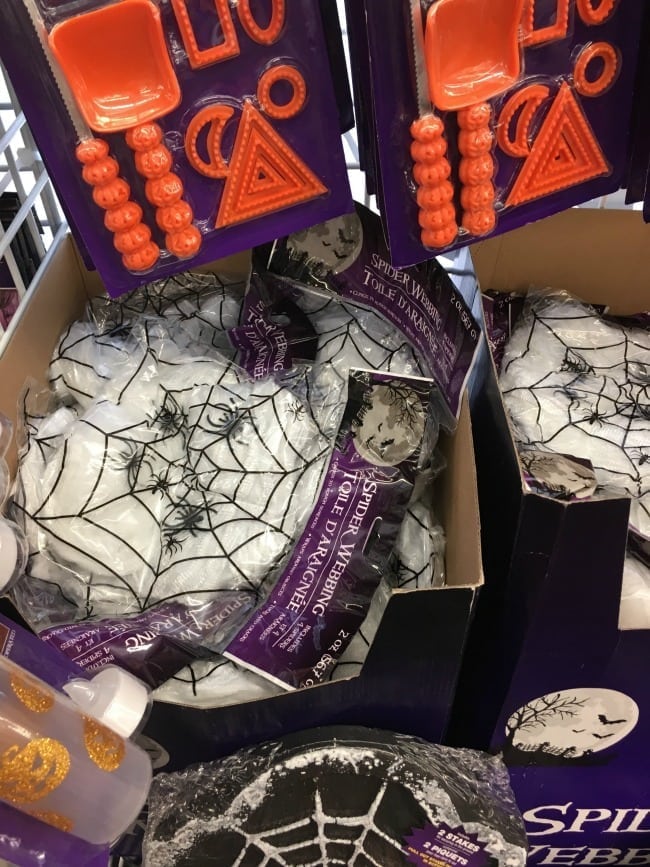

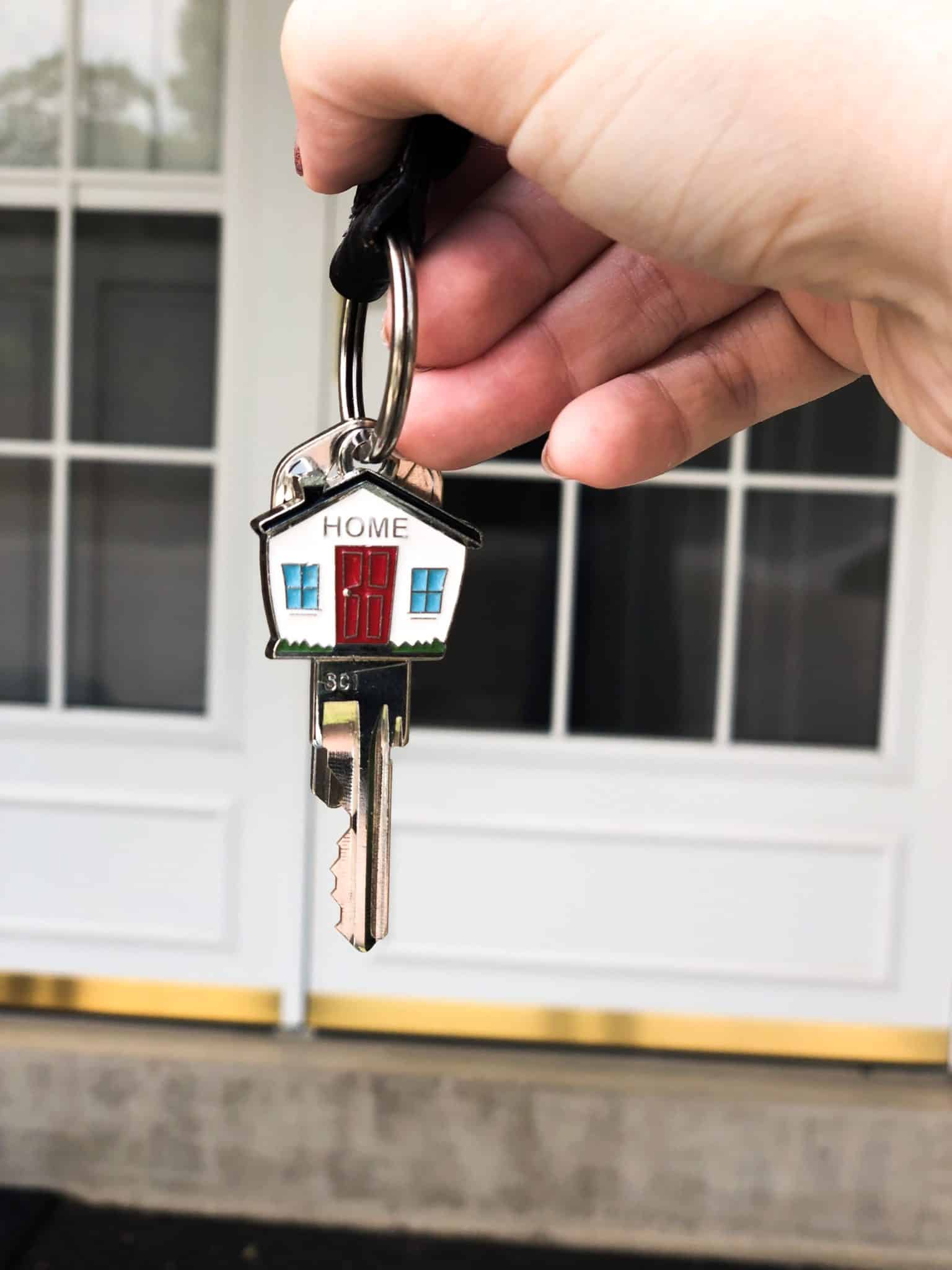
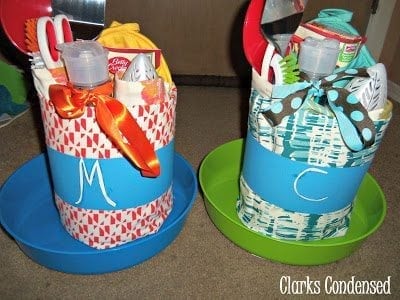
I make and sell cutting boards and serving boards. You can buy a food grade mineral oil. Combine it with a food grade bees wax and it makes a great paste. There are bunch of Yuotube videos on how to make the paste. Walnut oil is also a good choice. Be careful with olive oil as it can become rancid.
Great content and tips that every cutting board owner can follow through it, thanks for sharing.
Can you use tung oil?
I have coconut oil in a spray bottle, but don;t know if I should use it or not. It doesn’t say anything on the can about fractionated or food grade, etc.
Can Castor oil be used instead of mineral oil?
I am not sure, I am sorry!!
Would fractionated coconut oil work?
I haven’t tried that! If you do, please let us know!
The fractionated coconut oil was a fail. It soaked into the board easily enough but didn’t do much to protect it.
Oh darn! That’s too bad. THank you for sharing!!
Can you use this technique on bamboo boards?
I think so!
There’s one danger with this method: coconut oil, like any vegetable oil, can go rancid in the wood. Your best bet is a food grade mineral oil. Its dirt cheap (you can get it at the drug store), can never go rancid in the wood, and will preserve the wood.
I use coconut oil. I also use it on my wooden spoons. Keeps them looking like new and makes it easier to clean off sauces and cheese.
Great tip!
Can you use extra virgin oil on the cutting board??
From what I have read, that is not recommended.
Katie, my husband makes Curly Koa and Sandalwood cutting boards. We always do a lemon and sea salt wash..not soak it..then dry..then add food grade mineral oil..both sides. The cutting boards are 30 years plus and beautiful.my hubby is an artist here in Hawaii. His work is just beautiful! Hope this tip works.
Oh I bet those are beautiful! Thank you for the wonderful tip!
Will this work on the cutting boards that are the pull out built in the counters? I hardly use it because it’s to hard to clean and I think that would make it better.
I certainly think so! We have one of these but it’s laminate. I’d love to hear if you try!
Good tips. Instead of buying expensive cutting board oil … use mineral oil. Read the ingredients of the cutting board oil. Yep it is mineral oil. You can find it in your local store next to the rubbing alcohol.
Great tip!
Make sure it is food grade mineral oil, the cost is about the same as board oil
Great to know!
Do you know if I can do this on my counter top? I have a wooded top on my island.
You should be able to!
I have a center island table that is made of wood. It gets stained with oily foods that are put on it after cooking. I put salt on the stains & rub it with a lemon & leave it sit over night. In the morning, I wash it all off & no more stains! I don’t oil it because I like the raw look, but it removes all the stains.
I highly recommend not using the same cutting board for meat as you use for anything else! It is too easy for the wood to soak up those meaty juices, and I would always be concerned about contaminating fruits and vegetables. I have a plastic one I reserve for meat, and the wooden one is for everything else.
I agree with this poster. Use plastic boards for all your raw meat cutting and wood ones for your veggies. The plastic boards can be cleaned in the dishwasher and/or soaked in bleach water every now and then to help sanitize it. And don’t forget your wooden knife handles. They can get dirty from cutting raw meats and need this same lemon/salt and oiling to keep them looking good.
Thank you for the tip!
Hi,
Just wondering if my Board is already a little warped and cracked, if following your steps it will come back to life?
Thanks!
K
I don’t know if your board would look completely like new, but I think it could definitely help. If anything, it will prevent it from getting worse.
One thing that we’ve done to keep the fruit from picking up funky meat smells is to label the two sides of the board “Fruit” and “Meat/Veg”. That way we’re always cutting the onions, garlic, and bits of meat on one side and slicing fruit on the other side and the two don’t mix.
This only works really well though if your not mixing the two styles in the same dish. Otherwise you could make your counter top kind of messy by flipping the cutting board over before you get a chance to wash it and let it dry.
That’s a great tip Ryan! Thank you. I think I will definitely be doing that now.
I didn’t know how to clean a wood cutting board. I have higher quality plastic boards that can go in the dishwasher. You’re right though, some of them are a little discolored. I love the look of the teak boards. Maybe I will try one of those out. So good to be doing this challenge with you.
WOW, I never knew how to care for my wooden cutting boards! Thanks!
Thanks for joining me in the challenge, Katie! We’re half way there!